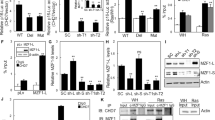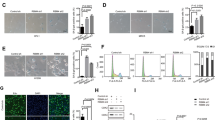Abstract
Overexpression of RasG12V in primary cells induces a permanent growth arrest called oncogene-induced senescence (OIS) that serves as a fail-safe mechanism against malignant transformation. We have performed a genome-wide small interfering RNA (siRNA) screen and a microRNA (miRNA) screen to identify mediators of OIS and show that siRNA-mediated knockdown of p21Waf1/Cip1 rescues from RasG12V-induced senescence in human mammary epithelial cells (HMECs). Moreover, we isolated a total of 28 miRNAs that prevented RasG12V-induced growth arrest, among which all of the miR-106b family members were present. In addition, we obtained a number of hits, miR-130b, miR-302a, miR-302b, miR302c, miR-302d, miR-512-3p and miR-515-3p with seed sequences very similar to miR-106b family members. We show that overexpression of all these miRNAs rescues HMECs from RasG12V-induced senescence by prevention of RasG12V-induced upregulation of p21Waf1/Cip1. Our results establish an important role for the cell cycle inhibitor p21Waf1/Cip1 in growth control of HMECs and extend the repertoire of miRNAs that modulate the activity of this tumour suppressor.
This is a preview of subscription content, access via your institution
Access options
Subscribe to this journal
Receive 50 print issues and online access
$259.00 per year
only $5.18 per issue
Buy this article
- Purchase on Springer Link
- Instant access to full article PDF
Prices may be subject to local taxes which are calculated during checkout




Similar content being viewed by others
References
Adnane J, Jackson RJ, Nicosia SV, Cantor AB, Pledger WJ, Sebti SM . (2000). Loss of p21WAF1/CIP1 accelerates Ras oncogenesis in a transgenic/knockout mammary cancer model. Oncogene 19: 5338–5347.
Braig M, Schmitt CA . (2006). Oncogene-induced senescence: putting the brakes on tumor development. Cancer Res 66: 2881–2884.
Calin GA, Croce CM . (2006). MicroRNA signatures in human cancers. Nat Rev Cancer 6: 857–866.
Carbone CJ, Graña X, Reddy EP, Haines DS . (2007). p21 loss cooperates with INK4 inactivation facilitating immortalization and Bcl-2-mediated anchorage-independent growth of oncogene-transduced primary mouse fibroblasts. Cancer Res 67: 4130–4137.
Costinean S, Zanesi N, Pekarsky Y, Tili E, Volinia S, Heerema N et al. (2006). Pre-B cell proliferation and lymphoblastic leukemia/high-grade lymphoma in E(mu)-miR155 transgenic mice. Proc Natl Acad Sci USA 103: 7024–7029.
Courtois-Cox S, Jones SL, Cichowski K . (2008). Many roads lead to oncogene-induced senescence. Oncogene 27: 2801–2809.
Elenbaas B, Spirio L, Koerner F, Fleming MD, Zimonjic DB, Donaher JL et al. (2001). Human breast cancer cells generated by oncogenic transformation of primary mammary epithelial cells. Genes Dev 15: 50–65.
Göhring UJ, Bersch A, Becker M, Neuhaus W, Schöndorf T . (2001). p21(waf) correlates with DNA replication but not with prognosis in invasive breast cancer. J Clin Pathol 54: 866–870.
He L, Thomson JM, Hemann MT, Hernando-Monge E, Mu D, Goodson S et al. (2005). A microRNA polycistron as a potential human oncogene. Nature 435: 828–833.
Huang Q, Gumireddy K, Schrier M, le Sage C, Nagel R, Nair S et al. (2008). The microRNAs miR-373 and miR-520c promote tumour invasion and metastasis. Nat Cell Biol 10: 202–210.
Ivanovska I, Ball AS, Diaz RL, Magnus JF, Kibukawa M, Schelter JM et al. (2008). MicroRNAs in the miR-106b family regulate p21/CDKN1A and promote cell cycle progression. Mol Cell Biol 28: 2167–2174.
Li G, Luna C, Qiu J, Epstein DL . (2009). Alterations in microRNA expression in stress-induced cellular senescence. Mech Ageing Dev 130: 731–741.
Li Y, Pan J, Li JL, Lee JH, Tunkey C, Saraf K et al. (2007). Transcriptional changes associated with breast cancer occur as normal human mammary epithelial cells overcome senescence barriers and become immortalized. Mol Cancer 6: 7.
Petrocca F, Visone R, Onelli MR, Shah MH, Nicoloso MS, de Martino I et al. (2008). E2F1-regulated microRNAs impair TGFbeta-dependent cell-cycle arrest and apoptosis in gastric cancer. Cancer Cell 13: 272–286.
Sarkisian CJ, Keister BA, Stairs DB, Boxer RB, Moody SE, Chodosh LA . (2007). Dose-dependent oncogene-induced senescence in vivo and its evasion during mammary tumorigenesis. Nat Cell Biol 9: 493–505.
Serrano M, Lin AW, McCurrach ME, Beach D, Lowe SW . (1997). Oncogenic ras provokes premature cell senescence associated with accumulation of p53 and p16INK4a. Cell 88: 593–602.
Sherr CJ, McCormick F . (2002). The RB and p53 pathways in cancer. Cancer Cell 2: 103–112.
Slamon DJ, Godolphin W, Jones LA, Holt JA, Wong SG, Keith DE et al. (1989). Studies of the HER-2/neu proto-oncogene in human breast and ovarian cancer. Science 244: 707–712.
Suh MR, Lee Y, Kim JY, Kim SK, Moon SH, Lee JY et al. (2004). Human embryonic stem cells express a unique set of microRNAs. Dev Biol 270: 488–498.
Voorhoeve PM, le Sage C, Schrier M, Gillis AJ, Stoop H, Nagel R et al. (2006). A genetic screen implicates miRNA-372 and miRNA-373 as oncogenes in testicular germ cell tumors. Cell 124: 1169–1181.
Wang Y, Baskerville S, Shenoy A, Babiarz JE, Baehner L, Blelloch R . (2008). Embryonic stem cell-specific microRNAs regulate the G1-S transition and promote rapid proliferation. Nat Genet 40: 1478–1483.
Wei W, Jobling WA, Chen W, Hahn WC, Sedivy JM . (2003). Abolition of cyclin-dependent kinase inhibitor p16Ink4a and p21Cip1/Waf1 functions permits Ras-induction anchorage-independent growth in telomerase-immortalized human fibroblasts. Mol Cell Biol 23: 2859–2870.
Weiss RH . (2003). p21Waf1/Cip1 as a therapeutic target in breast and other cancers. Cancer Cell 4: 425–429.
Wong TS, Liu XB, Wong BY, Ng RW, Yuen AP, Wei WI . (2008). Mature miR-184 as potential oncogenic microRNA of squamous cell carcinoma of tongue. Clin Cancer Res 14: 2588–2592.
Acknowledgements
This study was funded by Wellcome Programme Grant DERG1C3R (Viola Borgdorff, Marita G Overhoff); Marató TV3 Grant 052130-TV3 (Matilde E Lleonart); AGAUR fellowship 2007 BE-1 00296 (Matilde E Lleonart); MRC Project Grant DERB1A4R (Cleo L Bishop, Ann-Marie H Bergin); CRUK Project Grant DERG1F2R (Delphine Fessart). MELL is a FIS (Fondo de Investigación Sanitario) investigator (CP03/00101).
Author information
Authors and Affiliations
Corresponding author
Ethics declarations
Competing interests
The authors declare no conflict of interest.
Additional information
Supplementary Information accompanies the paper on the Oncogene website
Supplementary information
Rights and permissions
About this article
Cite this article
Borgdorff, V., Lleonart, M., Bishop, C. et al. Multiple microRNAs rescue from Ras-induced senescence by inhibiting p21Waf1/Cip1. Oncogene 29, 2262–2271 (2010). https://doi.org/10.1038/onc.2009.497
Received:
Revised:
Accepted:
Published:
Issue Date:
DOI: https://doi.org/10.1038/onc.2009.497
Keywords
This article is cited by
-
Senescence in osteoarthritis: from mechanism to potential treatment
Arthritis Research & Therapy (2022)
-
Age-related microRNAs in older breast cancer patients: biomarker potential and evolution during adjuvant chemotherapy
BMC Cancer (2018)
-
The RNA world of human ageing
Human Genetics (2018)
-
Epigenetic regulation in cell senescence
Journal of Molecular Medicine (2017)
-
A step-by-step microRNA guide to cancer development and metastasis
Cellular Oncology (2017)



